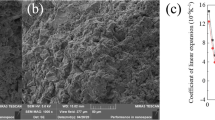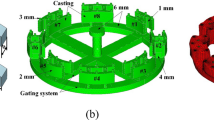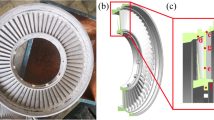Abstract
The deformation behavior of the mush zone for superalloy during investment casting directly affects the dimensional control of casting has puzzled many engineers and scientists for years. Numerical simulations are not directly useful to predict the most suitable pattern allowances. A new data-driven approach to be effectively used for pattern allowance and casting process parameters prediction is proposed. The constitutive relationships and deformation parameter from high-temperature mechanical tests on superalloy K4169 is reported. The inputs are alloy temperature, shell temperature, and pattern allowance with the outputs of diameter and ovality of the ring-to-ring casting, respectively. It turns out that the shell temperature is the most momentous factor that governs the dimensional variability in ovality. An RBF-based approximation model is established and the optimized parameters are the alloy temperature 1500.5°C, shell temperature1052.5°C, and the pattern allowance 1.7258%. The optimized results agree well with the observed in practical casting and the ring-to-ring casting tolerance has been optimized as required within CT6 grade. The proposed method is believed to benefit to provide theoretical guidance for casting practice. The data-driven approach used in this research can be easily applied to different materials and different kinds of casting that are subject to dimensional control upon solidification.








Similar content being viewed by others
Availability of data and materials
The manuscript has no associated data or the data will not be deposited.
References
Zhi XY, Han YJ, Yuan XM (2015) Casting process optimization for the impellor of 200ZJA slurry pump. Int J Adv Manuf Technol 77(9-12):1703–1710
Kuo JK, Huang PH, Guo MJ (2017) Removal of CrMo alloy steel components from investment casting gating system using vibration-excited fatigue failure. Int J Adv Manuf Technol 89(1-4):101–111
Dong YW, Li XL, Zhao Q, Yang J, Dao M (2017) Modeling of shrinkage during investment casting of thin-walled hollow turbine blades. J Mater Process Technol 244:190–203. https://doi.org/10.1016/j.jmatprotec.2017.01.005
Kochar VM (2006) Geometry dependent pattern allowance prediction for castings. https://etda.libraries.psu.edu/files/final_submissions/6413
Tian JW, Bu K, Song JH, Tian GL, Qiu F, Zhao DQ, Jin ZL, Li Y (2017) Optimization of investment casting process parameters to reduce warpage of turbine blade platform in DD6 alloy. China Foundry 14(6):469–477
Lewandowski MS, Overfelt RA (1999) high temperature deformation behavior of solid and semi-solid alloy 718. Acta Mater 47(11):4695–4710. https://doi.org/10.1016/S1359-6454(99)00252-9
Wang D, He B, Liu S, Liu C, Li F (2016) Dimensional shrinkage prediction based on displacement field in investment casting [J]. Int J Adv Manuf Technol 85(1-4):201–208. https://doi.org/10.1007/s00170-015-7836-1
Tamta K, Karunakar DB (2018) Enhancing mechanical properties and permeability of ceramic shell in investment casting process. Mater Manuf Process:1–12. https://doi.org/10.1080/10426914.2018.1532088
Anglada E, Meléndez A, Vicario I, Idoiaga JK, Mugarza A, Arratibel E (2018) Prediction and validation of shape distortions in the simulation of high pressure die casting. J Manuf Process 33:228–237. https://doi.org/10.1016/j.jmapro.2018.05.019
Koushik R, Indrajit B (2020) Analysis of mold tube distortion in steel continuous casting. SMCSTP 2020 Conference. TATA Steel and CSIR-NML, Jamshedpur, India
Zhu X, Wang F, Ma D, Bührig-Polaczek A (2020) Dimensional Tolerance of Casting in the Bridgman Furnace Based on 3D Printing Techniques. Metals 10(3):299. https://doi.org/10.3390/met10030299
Sangita, N. B.; Vikas, P.; Shankar, M. Productivity enhancement in investment casting foundry using automation technique in shelling operation. Ind Eng J 2019, 12(7): 1-13. DOI: 10.26488/IEJ.12.7.1177
Guo Y, Liu W, Guo Y, Zhang M, Zhang J (2020) Formation and evolution of porosity during high temperature creep of a nickel-based single crystal superalloy. E3S Web of Conferences 155. https://doi.org/10.1051/e3sconf/202015501005
Dini H, Andersson NE, Jarfors AEW (2020) Effect of process parameters on distortion and residual stress in high-pressure DieVCast AZ91D components after clean blasting and painting. Int J Met. https://doi.org/10.1007/s40962-020-00448-9
Chen J, Salvati E, Uzun F, Papadaki C, Wang Z, Everaerts J, Korsunsky AM (2020) An experimental and numerical analysis of residual stresses in a TIG weldment of a single crystal nickel-base superalloy. J Manuf Process 53:190–200. https://doi.org/10.1016/j.jmapro.2020.02.007
Farhang MF, Cockcroft S, Maijer D (2020) A fully-coupled thermal-stress model to predict the behavior of the casting-chill interface in an engine block sand casting process. Int J Heat Mass Transf 152:119490. https://doi.org/10.1016/j.ijheatmasstransfer
Kang JW, Long HM, Wang TJ, Huwang TY, Liu BC (2013) Evaluation of distortion of castings. Int J Cast Met Res 24(3/4):228–232. https://doi.org/10.1179/136404611x13001922708678
Zhang Y, Li X, He L, Ma C, Liu X, Mao Y (2019) Research for process on investment casting of impeller based on 3D printing. IOP Conf Ser Earth Environ 332:042047. https://doi.org/10.1088/1755-1315/332/4/042047
Richard CT, Kwok TH (2019) Rapid investment casting: design and manufacturing technologies. Proc. 39th ASME Int. Des. Eng. Tech. Conf. Comput. Inf. Eng. Conf. Anaheim, California, USA. August 2019. 18-21, V001T02A022. ASME. https://doi.org/10.1115/DETC2019-97554
Chen T, Tang YL, Liao DM, Cao L, Sun F, Teng ZH, Wu D (2017) Simulation of casting deformation based on mold surface element method. China Foundry 14(01):36–41. https://doi.org/10.1007/s41230-017-5106-6
Peters F, Voigt R, Ou SZ, Beckermann C (2007) Effect of mould expansion on pattern allowances in sand casting of steel. Int J Cast Met Res 20(5):275–287. https://doi.org/10.1179/136404607x268247
Wang Y, Shao WZ, Zhen L, Yang L, Zhang XM (2008) Flow behavior and microstructures of superalloy 718 during high temperature deformation. Mater Sci Eng A 497(1-2):479–486. https://doi.org/10.1016/j.msea.2008.07.046
Bathe LJ (1996) Use of constitutive relations. Finite elem. Proced. Prentice-Hall, New Jersey, pp 581–617
Kim KY, Sakuta H, Suzuki T (1991) In modeling of casting, welding and advanced solidification processes. VM Rappaz, K Mahan, and M Ozgu (eds.) TMS, Warrendale
Piwonka TS, Voller VR, Kategerman L (1993)“Modeling of casting, welding and advanced solidification processes VI.” Proc. of the sixth conference in a series on modeling casting and welding processes, Palm Coast, Florida
Rodriguez-Granrose D, Jones A, Loftus H, Tandeski T, Heaton W, Foley KT, Silverman L (2021) Design of experiment (DOE) applied to artificial neural network architecture enables rapid bioprocess improvement [J]. Bioprocess Biosyst Eng:1–8. https://doi.org/10.1007/s00449-021-02529-3
Kapur M, Gupta R, Mondal MK (2016) Parametric optimization of Cu (II) and Ni (II) adsorption onto coal dust and magnetized sawdust using box-behnken design of experiments [J]. Environ Prog Sustain Energy 35(6):1597–1604. https://doi.org/10.1002/ep.12393
Ahmadi M, Vahabzadeh F, Bonakdarpour B (2005) Application of the central composite design and response surface methodology to the advanced treatment of olive oil processing wastewater using Fenton’s peroxidation [J]. J Hazard Mater 123(1-3):187–195. https://doi.org/10.1016/j.jhazmat.2005.03.042
Quinonero J, Rasmussen CE (2005) A unifying view of sparse approximate Gaussian process regression [J]. J Mach Learn Res 6:1939–1959. https://doi.org/10.1007/s10846-005-9001-9
Zhao W, Fan F, Wang W (2017)Non-linear partial least squares response surface method for structural reliability analysis [J]. Reliab Eng Syst Saf 161:69–77. https://doi.org/10.1016/j.ress.2017.01.004
Guerreiro SF, Valente JF, Dias JR (2021)Box-Behnken design a key tool to achieve optimized PCL/gelatin electrospun mesh [J]. Macromol Mater Eng 2000678. https://doi.org/10.1002/mame.202000678
Perzyk M, Biernacki R, Kozlowski J (2008) Data mining in manufacturing: significance analysis of process parameters [J]. Proc Inst Mech Eng Part B 222(11):1503–1516. https://doi.org/10.1243/09544054JEM1182
Li G, Rabitz H, Yelvington PE, Oluwole OO, Bacon F, Kolb CE, Schoendorf J (2010) Global sensitivity analysis for systems with independent and/or correlated inputs [J]. J Phys Chem A 114(19):6022–6032. https://doi.org/10.1021/jp9096919
Funding
This work was financially supported by the National Key Research and Development Program of China (2020YFB1710101, 2020YFB1710102), China Postdoctoral Science Foundation (2020M671787), Zhejiang Postdoctoral Foundation (zj2019035), National Natural Science Foundation of China (51821001, 52090042), Major State Basic Research Development Program of Zhejiang (2020C01056, 2021C01157), Equipment Pre-Research Key Laboratory Fund Project (6142903200105), the fund of the State Key Laboratory of Solidification Processing in NWPU (Grant No. SKLSP202015), China Aviation Development Independent Innovation Project (ZZCX-2017-045), Science and Technology Project (K19209), and Major National Science and Technology Projects (2017-VII-008-0102, J2019-VI-0004-0117).
Author information
Authors and Affiliations
Contributions
Donghong, Wang: conceptualization, methodology, software, data curation, formal analysis, writing-original draft. Jiangping Yu: conceptualization, formal analysis, validation, writing—review and editing, funding acquisition. Changlin Yang: investigation, data curation. Xin Hao: supervision, writing—review and editing. Lin Zhang: supervision, resources. Yinghong Peng: supervision, funding acquisition.
Corresponding author
Ethics declarations
Ethics approval
This paper is the latest research. Neither the entire paper nor any part of its content has been published or has been accepted elsewhere. It is not being submitted to any other journal as well.
Consent to participate
Not applicable
Consent for publication
Not applicable
Competing interests
The authors declare no competing interests.
Disclaimer
The authors declare that they do not have any commercial or associative interest that represents a conflict of interest in connection with the work submitted.
Additional information
Publisher’s note
Springer Nature remains neutral with regard to jurisdictional claims in published maps and institutional affiliations.
Rights and permissions
About this article
Cite this article
Donghong, W., Yu, J., Yang, C. et al. Dimensional control of ring-to-ring casting with a data-driven approach during investment casting. Int J Adv Manuf Technol 119, 691–704 (2022). https://doi.org/10.1007/s00170-021-07539-9
Received:
Accepted:
Published:
Issue Date:
DOI: https://doi.org/10.1007/s00170-021-07539-9




